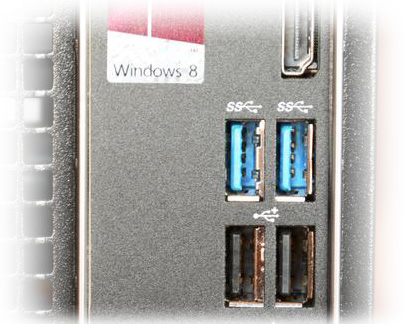USB 3.0
Posted on March 23, 2013 by KVMGalore | 0 comments

 USB 3.0 is the second major revision of the Universal Serial Bus (USB) standard for computer connectivity. First introduced in 2008, USB 3.0 adds a new transfer mode called "SuperSpeed," (distinguishable from USB 2.0 by either the blue color of the port or the initials SS) capable of transferring data at up to 5 Gbps - over 10 times faster than the 480 Gbps top speed of USB 2.0.
USB 3.0 is the second major revision of the Universal Serial Bus (USB) standard for computer connectivity. First introduced in 2008, USB 3.0 adds a new transfer mode called "SuperSpeed," (distinguishable from USB 2.0 by either the blue color of the port or the initials SS) capable of transferring data at up to 5 Gbps - over 10 times faster than the 480 Gbps top speed of USB 2.0.
The USB 3.0 specification is similar to USB 2.0 but with many improvements and an alternative implementation. The changes in this specification make improvements in the following areas:
- Transfer speed – Added a new transfer type called Super Speed or SS – 5 Gbps (electrically it is more similar to PCIe Gen2 and SATA than USB 2.0) - 10x the data transfer rate of Hi-Speed USB 2.0.
 Increased bandwidth – Instead of one-way communication, USB 3.0 uses two unidirectional data paths: one to receive data and the other to transmit.
Increased bandwidth – Instead of one-way communication, USB 3.0 uses two unidirectional data paths: one to receive data and the other to transmit.- Increased power output (in comparison to USB 2.0) - 5V, 1.8A.
- SuperSpeed USB 3.0 is a Sync-N-Go technology that minimizes user wait-time.
- Power management – SuperSpeed USB 3.0 provides Optimized Power Efficiency. No device polling and lower active and idle power requirements.
- Improved bus utilization – A new feature is added (using packets NRDY and ERDY) to let a device asynchronously notify the host of its readiness (no need of polling).
USB 3.0 plugs and connectors are usually colored blue, with the female connector typically marked with the USB SS symbol. SuperSpeed USB 3.0 is backwards compatible with USB 2.0. Devices inter-operate with USB 2.0 platforms. Hosts support USB 2.0 legacy devices.






